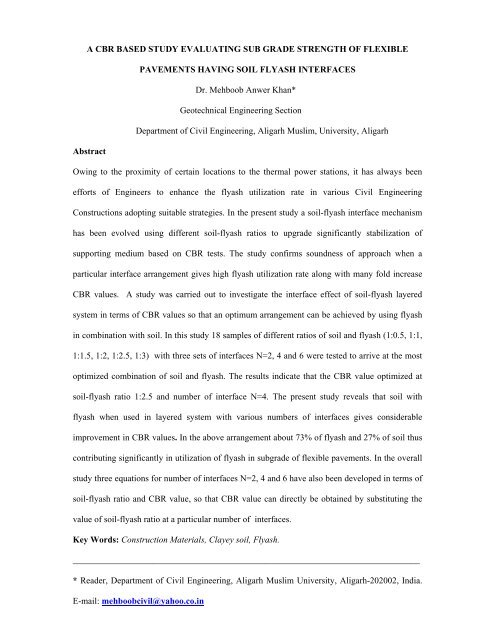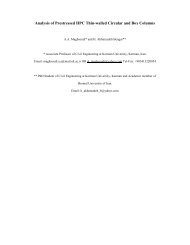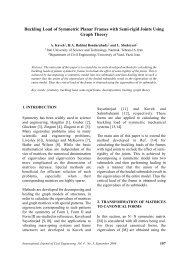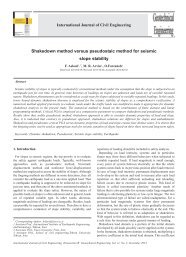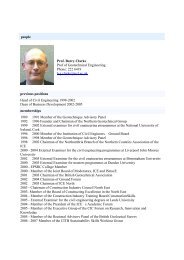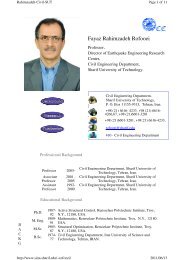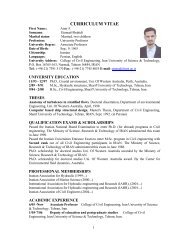A CBR BASED STUDY EVALUATING SUB GRADE STRENGTH OF ...
A CBR BASED STUDY EVALUATING SUB GRADE STRENGTH OF ...
A CBR BASED STUDY EVALUATING SUB GRADE STRENGTH OF ...
Create successful ePaper yourself
Turn your PDF publications into a flip-book with our unique Google optimized e-Paper software.
A <strong>CBR</strong> <strong>BASED</strong> <strong>STUDY</strong> <strong>EVALUATING</strong> <strong>SUB</strong> <strong>GRADE</strong> <strong>STRENGTH</strong> <strong>OF</strong> FLEXIBLE<br />
PAVEMENTS HAVING SOIL FLYASH INTERFACES<br />
Dr. Mehboob Anwer Khan*<br />
Geotechnical Engineering Section<br />
Department of Civil Engineering, Aligarh Muslim, University, Aligarh<br />
Abstract<br />
Owing to the proximity of certain locations to the thermal power stations, it has always been<br />
efforts of Engineers to enhance the flyash utilization rate in various Civil Engineering<br />
Constructions adopting suitable strategies. In the present study a soil-flyash interface mechanism<br />
has been evolved using different soil-flyash ratios to upgrade significantly stabilization of<br />
supporting medium based on <strong>CBR</strong> tests. The study confirms soundness of approach when a<br />
particular interface arrangement gives high flyash utilization rate along with many fold increase<br />
<strong>CBR</strong> values. A study was carried out to investigate the interface effect of soil-flyash layered<br />
system in terms of <strong>CBR</strong> values so that an optimum arrangement can be achieved by using flyash<br />
in combination with soil. In this study 18 samples of different ratios of soil and flyash (1:0.5, 1:1,<br />
1:1.5, 1:2, 1:2.5, 1:3) with three sets of interfaces N=2, 4 and 6 were tested to arrive at the most<br />
optimized combination of soil and flyash. The results indicate that the <strong>CBR</strong> value optimized at<br />
soil-flyash ratio 1:2.5 and number of interface N=4. The present study reveals that soil with<br />
flyash when used in layered system with various numbers of interfaces gives considerable<br />
improvement in <strong>CBR</strong> values. In the above arrangement about 73% of flyash and 27% of soil thus<br />
contributing significantly in utilization of flyash in subgrade of flexible pavements. In the overall<br />
study three equations for number of interfaces N=2, 4 and 6 have also been developed in terms of<br />
soil-flyash ratio and <strong>CBR</strong> value, so that <strong>CBR</strong> value can directly be obtained by substituting the<br />
value of soil-flyash ratio at a particular number of interfaces.<br />
Key Words: Construction Materials, Clayey soil, Flyash.<br />
______________________________________________________________________________<br />
* Reader, Department of Civil Engineering, Aligarh Muslim University, Aligarh-202002, India.<br />
E-mail: mehboobcivil@yahoo.co.in
1. Introduction<br />
The increasing demands of electrical energy and ample coal reserve in India have resulted in the<br />
construction of many coal-fired power plants. Most of the power plants, which are being<br />
constructed, or have been proposed, are also coal-fired plants. As a result the production of the<br />
power plant waste ash has also increased. They use pulverized coal of high ash content (45%) and<br />
produces bottom ash and flyash. The portion of the ash, which is classified as flyash and<br />
constitutes about 30-60% of total ash escapes with flue gases which is collected through<br />
Electrostatic Precipitators. Since coal is supplied from twenty-two different coal mines of Bihar,<br />
the chemical properties also vary to a great extent. With the increasing use of low-grade coal with<br />
high ash content, the annual production of flyash is about 100 million tones. Most of the ash<br />
generated from the power plant is disposed off in the vicinity of the power plant as the waste<br />
material covering several hectares of valuable land. Most developed and developing countries all<br />
over the world have huge resources of fly ash. The quantity of flyash that is accumulating in<br />
developed and developing countries is causing disposal problems that are both financially and<br />
environmentally expensive. The bulk utilization of flyash has become very essential in view of its<br />
huge production and increasing scarcity of disposal sites. Utilization in geotechnical applications<br />
such as land reclamation, sub grade/soil improvement, structural fills etc. has the potential for<br />
bulk utilization. Though the flyash is being used as a constructional material in many civil<br />
engineering projects, but its use as a general fill has a long history. When used in embankment for<br />
the construction of highways, the design life as well as the cost of maintenance of highways may<br />
get affected. Flyash is now being put in several countries for the stabilization of soil for the<br />
construction of roads and runway bases. Speedy and effective utilization of flyash has been<br />
recognized as a problem of national importance and in 1988, C.R.R.I. organized a workshop on<br />
“Utilization of Flyash”.<br />
In the present study, soil-flyash interface mechanism has been evolved using different soil-flyash<br />
ratios to upgrade significantly stabilization of supporting medium based on <strong>CBR</strong> tests. The study<br />
confirm soundness of approach when a particular interface arrangement gives high flyash<br />
utilization rate along with many folds increase in <strong>CBR</strong> values. The detailed investigations are
therefore necessary in order to understand the response of the layered system of soil and flyash<br />
with numbers of layers and interfaces. This paper presents the results of an experimental study of<br />
<strong>CBR</strong> tests performed on the soil-flyash ratios of 1:0.5, 1:1, 1:1.5, 1:2, 1:2.5 and 1:3 in layered<br />
system with number of interfaces, N=2, 4 and 6.<br />
2. Review of Literature<br />
Benson and Khire used cut pieces of waste milk jugs randomly distributed in a compacted finegrained<br />
soil and showed that there is an increase in <strong>CBR</strong> value by a factor of 5 [1]. Kumar et al.<br />
based on their laboratory investigations conducted on silty sand and pond ash specimens<br />
reinforced with randomly distributed polyester fibres, concluded that the fibres increased the<br />
<strong>CBR</strong> value and ductility of the specimens. They also reported that the optimum fibre content for<br />
both silty sand and pond ash was approximately 0.3%-0.4% of dry unit weight [2]. Kaniraj and<br />
Havanagi conducted unconfined compression tests on cement-stabilized fibre-reinforced fly ashsoil<br />
mixtures and concluded that randomly oriented polyester fibre changed the brittle behaviour<br />
to ductile behaviour[3]. Phanikumar and Sharma Studied the effect of fly ash on engineering<br />
properties of expansive soil through an experimental programme like free swell index (FSI), swell<br />
potential, swelling pressure, plasticity, compaction, strength and hydraulic conductivity of<br />
expansive soil. The ash blended expansive soil with flyash contents of 0, 5, 10, 15 and 20% on a<br />
dry weight basis and they inferred that increase in flyash content reduces plasticity characteristics<br />
and the FSI was reduced by about 50% by the addition of 20% fly ash. The hydraulic<br />
conductivity of expansive soils mixed with flyash decreases with an increase in flyash content,<br />
due to the increase in maximum dry unit weight with an increase in flyash content. When the<br />
flyash content increases there is a decrease in the optimum moisture content and the maximum<br />
dry unit weight increases. The undrained shear strength of the expansive soil blended with flyash<br />
increases with the increase in the ash content [4]. Misra et al., Senol et al.and Arora et al. used the<br />
flyash successfully for stabilizing expansive clays and the strength characteristics of flyash<br />
stabilized clays are measured by means of unconfined compressive strength (UCS) and California<br />
Bearing Ratio (<strong>CBR</strong>) values. Depending upon the soil type, the effective flyash content for<br />
improving the engineering properties of the soil varies between 15 to 30% [5, 6, 7]. Dutta and
Sarda carried out an experimental study to investigate the <strong>CBR</strong> behaviour of waste plastic strip<br />
reinforced stone dust/fly ash overlying saturated clay. Three different sizes of waste plastic strips<br />
were used and the effect of waste plastic strip content (0.25% to 4%) and length on the <strong>CBR</strong> and<br />
secant modulus of strip reinforced-stone dust/fly ash overlying saturated clay resulted in an<br />
appreciable increase in the <strong>CBR</strong> and the secant modulus [8].<br />
Yetimoglu et al. conducted <strong>CBR</strong> tests on sand fills reinforced with randomly distributed discrete<br />
fibres overlying soft clay. Their study reveals that adding fibre to sand fill resulted in an<br />
appreciable increase in the peak piston load. However, the initial stiffness of the load-penetration<br />
curves was not significantly affected by fibre reinforcement. The test results further showed that<br />
increasing fibre reinforcement content could increase the brittleness of the fibre-reinforced sand<br />
fill-soft clay system. The disagreement among the reported results is attributed to the difference<br />
in the material properties and testing conditions [9].<br />
Choudhary and Verma studied the effectiveness of utilizing flyash in the construction of<br />
pavement after suitably reinforcing it with two different types of reinforcement, namely, model<br />
geogrid and jute geotextiles. The reinforced flyash undertaken, a series of laboratory <strong>CBR</strong> tests<br />
were conducted on flyash specimens with and without reinforcement. The effect of depth of<br />
reinforcement from the top surface of the compacted flyash specimen as well as varying number<br />
of reinforcing layers at equal vertical spacing within the specimen on the <strong>CBR</strong> characteristics of<br />
flyash were studied. The maximum strength ratio (<strong>CBR</strong> reinforced to <strong>CBR</strong> unreinforced ) of 2.99 was<br />
observed when the geogrid was placed at an embedment ratio of 1. The strength ratio ranges from<br />
2.64 to 4.06 when the number of reinforcing layers varied from 2 to 4. The embedment ratio of<br />
the four geotextiles was 0.25, 0.5, 0.75, 1 [10]. Prasad et al. carried out <strong>CBR</strong> and direct shear tests<br />
for finding the optimum percentages of waste plastics and waste tyre rubber in gravel subbase<br />
material. Based on these results, laboratory model pavement studies were conducted with<br />
optimum percentage of waste plastics and waste tyre rubber in gravel subbase, laid on expansive<br />
soil subgrade in the flexible pavement system. The load carrying capacity of the model flexible<br />
pavement system significantly increased when the gravel subbase was reinforced with waste<br />
plastics as well as waste tyre rubber when compared to unreinforced subbase [11]. Robert M.
Brooks upgraded expansive soil as a construction material using waste materials rice husk ash<br />
(RHA) and flyash. Stress strain behavior of unconfined compressive strength showed that failure<br />
stress and strains increased by 106% and 50% respectively when the flyash content was increased<br />
from 0 to 25%. When the RHA content was increased from 0 to 12%, Unconfined Compressive<br />
Stress increased by 97% while <strong>CBR</strong> improved by 47% [12]. Prasad and Prasada Raju investigated<br />
the performance of flexible pavement on expansive soil subgrade using gravel/flyash as subbase<br />
course with waste tyre rubber as a reinforcing material. They observed that from the laboratory<br />
test results of direct shear and <strong>CBR</strong> tests for gravel and flyash materials reinforced with different<br />
percentage of waste tyre rubber, the optimum percentages of waste tyre rubber are equal to 5%<br />
and 6% of dry unit weight of soil, respectively. The load carrying capacity of the laboratory<br />
model flexible pavement system has significantly increased for both gravel and flyash subbases<br />
reinforced with optimum percentage waste tyre rubber laid on expansive soil subgrade. No<br />
significant control of heave is observed for the laboratory model flexible pavements for both the<br />
gravel and flyash reinforced with waste tyre rubber tried in this investigation, laid on expansive<br />
soil subgrade [13].<br />
The literature presented above clearly indicates that the influence of layered system of soil-flyash<br />
ratios with number of interfaces on the <strong>CBR</strong> behaviour has not been investigated so far.<br />
Therefore, the main purpose of this paper is to present the results of <strong>CBR</strong> tests with various soilflyash<br />
ratios and number of interfaces. Effects of number of interfaces between soil-flyash layers<br />
on load-penetration behaviour and obtained an optimized arrangement of soil flyash layered<br />
system for the construction of flexible pavements.<br />
3. Materials Characteristic<br />
3.1 Flyash Used<br />
The flyash used was collected from the only coal-based Harduaganj Thermal Power Plant of Uttar<br />
Pradesh located 14 km. North of Aligarh City by side of upper Ganga Canal. The plant has an<br />
installed capacity of 440 MW of electricity with the maximum flyash production capacity of<br />
about 100 tons per annum. The flyash from the plant was collected in a dry form from hoppers<br />
and transported in air tight double polythene bags. The chemical composition of the flyash along
with its physical and geotechnical properties obtained by characterization in the laboratory are<br />
given in Table1.<br />
3.2 Soil Investigated<br />
The soil for the present investigation was sampled from the campus of the Aligarh Muslim<br />
University, Aligarh. As per IS Classification System, the soil is classified as CL. The index and<br />
other geotechnical properties of soil are given in Table 2. The grain size distribution of both the<br />
experimental soil and flyash are shown in Fig. 9.<br />
4. Experimental Procedure<br />
A detailed experimental work has been taken-up covering various properties viz., liquid limit,<br />
plastic limit, compaction, specific gravity, shear strength parameters, compression index and<br />
coefficient of consolidation. The flyash used in this investigation is obtained from Harduaganj<br />
Thermal Power Plant of Uttar Pradesh near Aligarh. The flyash collected is dried, sieved through<br />
425 microns and stored in airtight containers in the laboratory. The particle size distribution curve<br />
of flyash shows that more than 90% of flyash is passing through 0.075 mm IS sieve. The majority<br />
of flyash particles used in this investigation is of silt size. The soil used in this investigation is air<br />
dried, pulverized and sieved through 4.75mm IS sieve. The samples thus obtained are stored in<br />
airtight containers in the laboratory. The OMC of plain soil and flyash is determined by standard<br />
proctor compaction test and then remoulded specimens of <strong>CBR</strong> of soil, flyash and layers of soil<br />
and flyash are prepared in laboratory at standard proctor density. Different samples were prepared<br />
in the similar lines for <strong>CBR</strong> test using soil and flyash materials in various ratios and number of<br />
interfaces. After soaking test, the <strong>CBR</strong> mould is placed on the <strong>CBR</strong> testing machine with<br />
minimum surcharge of 4.5 kg. A plunger of 50 mm diameter is allowed to penetrate into the<br />
specimen at the rate of 1.25 mm/min. and the penetration of the plunger is recorded by the dial<br />
gauge and resistance to penetration is recorded by the calibrated proving ring. A typical<br />
arrangement of samples of plain soil and plain flyash and various ratios of soil-flyash (S:F) 1:0.5,<br />
1:1, 1:1.5, 1:2, 1:2.5 and 1:3 which were prepared in layered system keeping number of interfaces<br />
N = 2, 4 and 6 as shown in Figs. 1 to 7. The <strong>CBR</strong> tests were conducted in the laboratory for all
the samples as per I.S. Code (IS: 2720 (Part-16)-1979). The <strong>CBR</strong> value is calculated by the<br />
relation<br />
<strong>CBR</strong> (%) = (Test load / Standard load) × 100<br />
The <strong>CBR</strong> value at 5.0 mm penetration is consistently higher than that of at 2.5 mm penetration<br />
and is reported as <strong>CBR</strong> value. The <strong>CBR</strong> values of plain soil, plain flyash and layered system of<br />
soil and flyash ratios (S:F) with numbers of interfaces (N) are given in Table 3. In the present<br />
investigation a limited effort is devoted to understand the possible mechanisms governing the<br />
behaviour of layered system of soil and flyash in relation to <strong>CBR</strong> values.<br />
5. Results and Discussions<br />
The specific gravity of soil and flyash are obtained by density bottle method as 2.7 and 2.0<br />
respectively. The Liquid limit, Plastic limit and Plasticity index of soil are obtained by using<br />
Cassagrande’s apparatus as 28%, 18% and 10% respectively. Proctor Compaction Test was<br />
carried out on soil and flyash for the determination of optimum moisture content (OMC) and<br />
maximum dry density. The OMC and max dry density for soil are obtained as 16% and 18.3<br />
kN/m 3 and for flyash as 37.5% and 11.8 kN/m 3 respectively (Table 1 and 2). The variation of dry<br />
density with moisture content of plain soil was rapid but for plain flyash was slow as shown in<br />
Fig. 8.<br />
The experimental results established a basis for investigating the relationship between California<br />
Bearing Ratio (<strong>CBR</strong>) of soil, flyash and layered system of soil-flyash ratios with different number<br />
of interfaces. The <strong>CBR</strong> tests were conducted on each sample as close to the optimum moisture<br />
content (OMC) as possible. After the <strong>CBR</strong> test, the <strong>CBR</strong> values of soaked samples of plain soil,<br />
plain flyash and soil flyash ratios with number of interfaces were obtained by plotting curves of<br />
penetration resistance vs. penetration as shown in Figs. 10 to 16. The penetration resistance for<br />
2.5 mm and 5 mm penetration were obtained from the curve and the corresponding <strong>CBR</strong> values<br />
for samples were calculated by dividing the penetration load with the standard load and<br />
multiplying by 100. The desired <strong>CBR</strong> value was chosen as the greater of the computed values at<br />
2.5 mm and 5 mm penetration. The <strong>CBR</strong> tests were first performed on plain soil and flyash<br />
samples and then on the various ratios of soil and flyash (1:0.5, 1:1, 1:1.5, 1:2, 1:2.5 and 1:3) in
layered system with number of interfaces, N = 2, 4 and 6. The <strong>CBR</strong> values for plain soil and<br />
flyash were found to be 3.62% and 5.77% respectively. In over all study, it was observed that at<br />
any soil flyash ratio, the <strong>CBR</strong> value is optimized at number of interfaces, N = 4. The <strong>CBR</strong><br />
showed an upward trend throughout in the layered system having various interfaces, however the<br />
maximum value of <strong>CBR</strong> was found to be 10.7% at number of interfaces N = 4 which is a<br />
significant achievement (Table 4).<br />
At any soil-flyash ratio, if the number of interfaces of soil and flyash increases, the thickness of<br />
the soil gets reduced and the interlocking between the soil and flyash consequently decreases and<br />
giving lower <strong>CBR</strong> values. The maximum improvement in the <strong>CBR</strong> values of soil and flyash are<br />
195% and 85% respectively at soil-flyash ratio 1:2.5 and number of interface, N = 4.<br />
As the thickness of the soil layers in between the layers of flyash decreases along with the<br />
increase in number of interfaces and ratios, the system could resist the shearing load up to a<br />
particular limit. The number of interfaces increased more than N = 4 and ratio 1:2.5, the specimen<br />
sustains lesser load for the same penetration giving lower <strong>CBR</strong> values. When soil is compacted<br />
with flyash in layered system, the frictional and shearing component of the mass of soil and<br />
flyash retain due to grain-to-grain contact at the interfaces of soil and flyash and drainage is<br />
allowed from top and bottom which increases the shear strength and stability of soil and flyash<br />
and gives higher <strong>CBR</strong> values.<br />
Three equations in terms of <strong>CBR</strong> values for various soil-flyash ratio with number of interfaces, N<br />
= 2, 4 and 6 are obtained as shown in Fig. 17. A equation for <strong>CBR</strong> values has been derived in<br />
terms of soil and flyash ratios (S:F) and number of interfaces (N) as given below.<br />
y=C 1 x 3 +C 2 x 2 +C 3 x+C 4 (1)<br />
Where, y = <strong>CBR</strong> value (%) and x = Soil-flyash ratio (S:F)<br />
For N = 2, C 1 = -0.57, C 2 = 2.91, C 3 = - 3.50, C 4 = 5.10<br />
For N = 4, C 1 = -1.59, C 2 = 8.50, C 3 = - 10.4, C 3 = 7.77<br />
For N = 6, C 1 = -1.11, C 2 = 5.97, C 3 = - 7.46, C 3 = 6.61,<br />
From the above eq.(1), the <strong>CBR</strong> values can be obtained for any soil-flyash ratio corresponding to<br />
number of interfaces, N = 2, 4 and 6.
In present study, the pavement thickness vs <strong>CBR</strong> values curves of soil flyash ratios with number<br />
of interfaces have been plotted as shown in Fig. 18. From these curves, the optimized thickness of<br />
pavement can be obtained corresponding to soil-flyash ratio and number of interfaces.<br />
6. Conclusions<br />
The following conclusions have been drawn from the present study.<br />
Swelling is completely eliminated when compared to plain soil, because flyash which is<br />
sandwiched between the soils layers act as a drainage face to absorb excess moisture from soil<br />
layers. Thus checking swelling and not allowing it expand or undergoing any volume change.<br />
The maximum <strong>CBR</strong> value obtained for soil-flyash sample having ratio (S:F) 1:2.5 with number of<br />
interfaces N = 4. In the same arrangement, the soil and flyash component are 27% and 73%<br />
respectively.<br />
The maximum percentage increase in the <strong>CBR</strong> values with respect to plain soil and flyash were<br />
obtained as 195% and 85% respectively.<br />
The stabilization of soil by using flyash in layered system along with the interfaces provides a<br />
strong material for sub grade and base course of roads and runway pavements, especially in areas<br />
surrounding the thermal power plants.<br />
The study confirms that considerably high amount of thermal waste (flyash) can be used, which<br />
prevent environmental pollution and saving our valuable land and handle disposal problem of<br />
flyash from dump yards.<br />
A general equation, y = C 1 x 3 + C 2 x 2 +C 3 x + C 4 has been generated for <strong>CBR</strong> values, y (%) in terms<br />
of soil-flyash ratio (S:F), x and number of interfaces (N).<br />
7. References<br />
1. Benson, C.H. and Khire, M.U.: 1994, Reinforcing Sand with Strips of Reclaimed High-Density<br />
Polyethylene, Journal of Geotechnical Engineering, 121, 838-855.<br />
2. Kumar, R., Kanaujia V.K. and Chandra D.: 1999, Engineering Behavior of Fiber- Reinforced<br />
Pond Ash and Silty Sand, Geosynthetics International Journal, 6, 509-518.
3. Kaniraj, S.R. and Havanagi, V.G.: 2001, Behavior of Cement-Stabilized Fiber-Reinforced Fly<br />
Ash-Soil Mixtures, Journal of Geotechnical and Geoenvironmental Engineering, 127, 574-<br />
584.<br />
4. Phanikumar B.R., and Radhey S.Sharma: 2004, Effect of flyash on Engineering properties of<br />
Expansive Soil, Journal of Geotechnical and Geoenvironmental Engineering, 130 (7), 764-<br />
767.<br />
5. Misra, A: 2000, Stabilization Characteristics of Clays Using Class C Fly Ash, Transportation<br />
Research Record, Transportation Research Board, National Research Council, Washington,<br />
D.C, 1611, 46-54.<br />
6. Senol, A., Md. S. Bin-Shafique, T. B. Edil, and C.H. Benson: 2002, Use of Class C Fly Ash for<br />
Stabilization of Soft Subgrade, Fifth International Congress on Advances in Civil Engineering,<br />
Istanbul Technical University, Turkey.<br />
7. Arora, S and Aydilek, A. H.: 2005, Class F Fly-Ash-Amended Soils as Highway Base<br />
Materials, ASCE Journals of Materials, 17 (6), 640-649.<br />
8. Dutta, R.K and Sarda, V.K.: 2006, <strong>CBR</strong> Behaviour of Waste Plastic Strip-reinforced Stone<br />
dust/Flyash Overlying Saturated Clay, Journal of Turkish Engineering Environmental<br />
Science, 31, 760-767.<br />
9. Yetimoglu, T., Inanir, M. and Inanir, O.E.: 2005, A Study on Bearing Capacity of Randomly<br />
Distributed Fiber-Reinforced Sand Fills Overlying Soft Clay, Geotextiles and Geomembranes,<br />
23, 174-184.<br />
10. Choudhary, A.K. and Verma, B.P.: 2005, Behaviour of Reinforced Flyash Subgrades, Journal<br />
of Institution of Engineers (India) Civil Engineering Division, 86, 19-21.<br />
11. Prasad, Prasada Raju, Ramana Murthy: 2008, Use of Waste Plastic and Tyre in Pavement<br />
Systems, IE(I) Journal-CV, 89, 31-35.<br />
12. Robert M. Brooks: 2009, Soil Stabilization with Flyash and Rice Husk Ash, International<br />
Journal of Research and Reviews in Applied Sciences, 1 (3), 209-213.
13. Prasad D.S.V. and Prasada Raju G.V.R.: 2009, Performance of Waste Tyre Rubber on Model<br />
Flexible Pavement, Asian Research Publishing Network Journal of Engineering and Applied<br />
Sciences, 4 (6), 89-92.
Table1. Chemical Composition, Physical and Geotechnical Properties of FlyAsh.<br />
Properties<br />
Value<br />
Chemical Composition (%)<br />
Silica (SiO 2 ) 50 - 60<br />
Alumina (Al 2 O 3 ) 15-28<br />
Iron Oxide (Fe 2 O 3 ) 5-10<br />
Lime (CaO) 3-6<br />
Magnesia (MgO) 1-2<br />
Soda (Na 2 O) --<br />
Potash (K 2 O) --<br />
Manganese Oxide (MnO) 1-2<br />
Physical Properties<br />
Specific gravity 2.06<br />
Loss on ignition (%) 5-6<br />
Geotechnical Properties<br />
Maximum dry density (kN/m 3 ) 11.8<br />
Optimum moisture content (%) 37.5<br />
Percentage finer-75 micron (%) 92<br />
Compression index 0.07<br />
Coefficient of consolidation at 200.0 kN/m 2 pressure (m 2 /sec.) 2.985 × 10 -8<br />
Permeability at dry density of 1.18 gm/cm3 (m/sec) 4.88 × 10 -7<br />
Unconfined compressive strength at MDD (kN/m 2 ) 110<br />
Cohesion (kN/m 2 ) 6.8<br />
Angle of shearing resistance<br />
32 o<br />
<strong>CBR</strong> at dry density of 11.8 kN/m 3 5.77
Table 2. Physical and Geotechnical Properties of Soil<br />
Properties<br />
IS Classification<br />
Value<br />
CL<br />
Liquid limit (%) 28<br />
Plastic limit (%) 18<br />
Plasticity index (%) 10<br />
Specific gravity 2.70<br />
Grain size distribution<br />
Gravel (%) 0.0<br />
Sand (%) 24<br />
Silt (%) 66<br />
Clay (%) 10<br />
Maximum dry density, MDD (kN/m 3 ) 18.3<br />
Optimum moisture content, OMC (%) 16.0<br />
Unconfined compressive strength at MDD (kN/m 2 ) 175<br />
Cohesion (kN/m 2 ) 25<br />
Angle of shearing resistance<br />
13 o<br />
<strong>CBR</strong> value at dry density of 11.8 kN/m 3 3.62
Table 3. <strong>CBR</strong> Values of Different Samples of Soil and Flyash<br />
<strong>CBR</strong> Values<br />
Samples<br />
At penetration<br />
2.5 mm<br />
At penetration<br />
5.0 mm<br />
Plain Soil 2.7 3.62<br />
Plain Flyash 4.1 5.77<br />
Soil-Flyash Ratio (S:F)<br />
Number of interfaces (N)<br />
N = 2 3.36 3.92<br />
1:0.5<br />
N = 4 4.21 4.29<br />
N = 6 3.64 4.11<br />
N = 2 3.92 4.13<br />
1:1<br />
N = 4 4.37 4.62<br />
N = 6 4.04 4.37<br />
N = 2 3.64 4.41<br />
1:1.5<br />
N = 4 5.47 6.10<br />
N = 6 5.10 5.21<br />
N = 2 3.92 4.80<br />
1:2<br />
N = 4 5.93 6.88<br />
N = 6 4.77 5.65<br />
N = 2 4.74 5.40<br />
1:2.5<br />
N = 4 8.75 10.70<br />
N = 6 7.90 8.50<br />
N = 2 4.74 4.80<br />
1:3<br />
N = 4 8.51 9.73<br />
N = 6 5.73 7.64
SOIL<br />
S<br />
FLY ASH<br />
F<br />
150.00 150.00<br />
(a)<br />
FIGURE 1 : Plain Soil and Flyash<br />
(b)<br />
Ratio 1:0.5,N = 2<br />
Ratio 1:0.5,N=4<br />
Ratio 1:0.5,N=6<br />
S<br />
50.00<br />
S<br />
33.34<br />
S<br />
F<br />
F<br />
25.00<br />
S<br />
F<br />
50.00<br />
S<br />
33.33<br />
F<br />
F<br />
25.00<br />
S<br />
S<br />
50.00<br />
F<br />
S<br />
33.33<br />
S<br />
(a) (b) (c)<br />
FIGURE 2 : Layered System of Soil and Flyash Having Ratio 1: 0.5 and<br />
Number of Interfaces, N = 2, 4 and 6.<br />
25.00<br />
16.66<br />
25.00<br />
16.67<br />
25.00<br />
16.67<br />
25.00<br />
Ratio 1:1, N=2 Ratio 1:1, N=4 Ratio 1:1, N=6<br />
S<br />
F<br />
S<br />
37.50<br />
75.00<br />
37.50<br />
S<br />
F<br />
S<br />
F<br />
S<br />
25.00<br />
37.50<br />
25.00<br />
37.50<br />
25.00<br />
(a) (b) (c)<br />
FIGURE 3 : Layered System of Soil and Flyash Having Ratio 1:1 and<br />
Number of interfaces, N = 2, 4 and 6.<br />
S<br />
F<br />
S<br />
F<br />
S<br />
F<br />
S<br />
18.75<br />
25.00<br />
18.75<br />
25.00<br />
18.75<br />
25.00<br />
18.75
Ratio 1:1.5, N=2 Ratio 1:1.5, N=4<br />
S<br />
F<br />
S<br />
30.00<br />
90.00<br />
30.00<br />
S<br />
F<br />
S<br />
F<br />
S<br />
20.00<br />
45.00<br />
20.00<br />
45.00<br />
20.00<br />
Ratio 1:1.5, N=6<br />
(a) (b) (c)<br />
FIGURE 4 : Layered System of Soil and Flyash Having Ratio 1:1.5 and<br />
Number of Interfaces, N = 2, 4 and 6.<br />
S<br />
F<br />
S<br />
F<br />
S<br />
F<br />
S<br />
15.00<br />
30.00<br />
15.00<br />
30.00<br />
15.00<br />
30.00<br />
15.00<br />
Ratio 1:2, N=2 Ratio 1:2, N=4<br />
S<br />
F<br />
S<br />
25.00<br />
100.00<br />
25.00<br />
S<br />
F<br />
S<br />
F<br />
S<br />
16.66<br />
50.00<br />
16.67<br />
50.00<br />
16.67<br />
Ratio 1:2, N=6<br />
(a) (b) (c)<br />
FIGURE 5 : Layered System of Soil and Flyash Having Ratio 1:2 and<br />
Number of Interfaces, N = 2, 4 and 6.<br />
S<br />
F<br />
S<br />
F<br />
S<br />
F<br />
S<br />
12.50<br />
33.33<br />
12.50<br />
33.33<br />
12.50<br />
33.34<br />
12.50
Ratio 1:2.5, N=2<br />
S<br />
F<br />
S<br />
21.43<br />
107.14<br />
21.43<br />
Ratio 1:2.5, N=4<br />
S<br />
F<br />
S<br />
F<br />
S<br />
14.30<br />
53.57<br />
14.28<br />
53.57<br />
14.28<br />
Ratio 1:2.5, N=6<br />
S<br />
(a) (b) (c)<br />
FIGURE 6 : Layered System of Soil and Flyash Having Ratio 1:2.5 and<br />
Number of Interfaces, N = 2, 4 and 6.<br />
F<br />
S<br />
F<br />
S<br />
F<br />
S<br />
10.70<br />
35.70<br />
10.75<br />
35.70<br />
10.75<br />
35.70<br />
10.70<br />
Ratio 1:3, N=2 Ratio 1:3, N=4<br />
Ratio 1:3, N=6<br />
S<br />
18.75<br />
S<br />
12.50<br />
(s)<br />
F<br />
112.50<br />
S<br />
18.75<br />
(f )<br />
F<br />
56.25<br />
(s)<br />
S<br />
12.50<br />
(f )<br />
(s)<br />
F<br />
56.25<br />
(f )<br />
12.50<br />
(a) (b) (c)<br />
FIGURE 7 : Layered System of Soil and Flyash Having Ratio 1:3 and<br />
Number of Interfaces, N = 2, 4 and 6.<br />
All dimensions in mm<br />
S<br />
(s)<br />
9.37<br />
37.50<br />
9.38<br />
37.50<br />
9.38<br />
37.50<br />
9.37
20<br />
Plain Soil<br />
Plain Fly ash<br />
Dry Density (kN/m 3 )<br />
15<br />
10<br />
5<br />
5 10 15 20 25 30 35 40 45 50<br />
Moisture Content (%)<br />
FIGURE. 8 : Moisture Density Relationship of Soil and Fly ash<br />
Percent Finer by Weight<br />
100<br />
90<br />
80<br />
70<br />
60<br />
50<br />
Plain Soil<br />
40<br />
30<br />
Plain Fly ash<br />
20<br />
10<br />
0<br />
0.001 0.01 0.1 1 10<br />
Grain Size Diameter (mm)<br />
FIGURE 9 : Grain Size Distribution Curve for Soil and Fly Ash
250<br />
200<br />
Load (Kg)<br />
150<br />
100<br />
50<br />
Plain Soil<br />
Plain Fly ash<br />
0<br />
0 2 4 6 8 10 12 14<br />
Penetration (mm)<br />
Fig. 10: Load Penetration Curves for <strong>CBR</strong> Values of Plain Soil<br />
and Flyash<br />
150<br />
Load (Kg)<br />
100<br />
50<br />
Number of Interfaces, N = 2<br />
Number of Interfaces, N = 4<br />
Number of Interfaces, N = 6<br />
0<br />
0 2 4 6 8 10 12 14<br />
Penetration (mm)<br />
FIGURE 11 : Load Penetration Curves for Soil Fly ash Ratio 1:<br />
0.5 with Number of Interfaces, N=2, 4 and 6
200<br />
150<br />
Load (Kg)<br />
100<br />
50<br />
0<br />
0 2 4 6 8 10 12<br />
Penetration (mm)<br />
Number of Interfaces, N = 2<br />
Number of Interfaces, N = 4<br />
Number of Interfaces, N = 6<br />
FIGURE 12 : Load Penetration Curves for Soil Fly ash Ratio 1:1<br />
with Number of Inter faces, N = 2, 4, and 6<br />
14<br />
250<br />
200<br />
Load (Kg)<br />
150<br />
100<br />
50<br />
0<br />
0 2 4 6 8 10 12<br />
Penetration (mm)<br />
Number of Interfaces, N = 2<br />
Number of Interfaces, N = 4<br />
Number of Interfaces, N = 6<br />
FIGURE 13 : Load Penetration Curves for Soil Fly ash Ratio 1 :<br />
1.5 with Number of Interfaces, N = 2, 4 and 6<br />
14
Load (Kg)<br />
250<br />
200<br />
150<br />
100<br />
50<br />
Number of Interfaces, N = 2<br />
Number of Interfaces, N = 4<br />
Number of Interfaces, N = 6<br />
0<br />
0 2 4 6 8 10 12 14<br />
Penetration (mm)<br />
FIGURE 14 : Load Penetration Curves for Soil Fly ash Ratio 1 : 2<br />
with Number of Interfaces, N = 2, 4 and 6<br />
Load (Kg)<br />
400<br />
350<br />
300<br />
250<br />
200<br />
150<br />
100<br />
50<br />
0<br />
Number of Interfaces, N = 2<br />
Number of Interfaces, N = 4<br />
Number of Interfaces, N = 6<br />
0 2 4 6 8 10 12<br />
Penetration (mm)<br />
FIGURE 15 : Load Penetration Curves for Soil Fly ash Ratio 1 :<br />
2.5<br />
with Number of Interfaces, N = 2, 4 and 6<br />
14
350<br />
300<br />
Load ( Kg )<br />
250<br />
200<br />
150<br />
100<br />
50<br />
0<br />
Number of Interfaces, N = 2<br />
Number of Interfaces, N = 4<br />
Number of Interfaces, N = 6<br />
0.0 2.0 4.0 6.0 8.0 10.0 12.0 14.0<br />
Penetration (mm)<br />
FIGURE 16 : Load Penetration Curves for Soil Fly ash Ratio1:3<br />
with Number of Interfaces, N = 2, 4 and 6<br />
<strong>CBR</strong> Value (%)<br />
12<br />
10<br />
8<br />
6<br />
4<br />
2<br />
y = -0.57x 3 + 2.91x 2 - 3.52x + 5.10 for N = 2<br />
y = -1.59x 3 + 8.50x 2 - 10.48x + 7.77 for N = 4<br />
y = -1.11x 3 + 5.97x 2 - 7.46x + 6.61 for N = 6<br />
Number of Interfaces, N = 4<br />
Number of Interfaces, N = 6<br />
Number of Interfaces, N = 2<br />
0<br />
0 0.5 1 1.5 2 2.5 3 3.5<br />
Soil Fly ash Ratio<br />
FIGURE 17 : Effect of Soil Fly ash Raio on <strong>CBR</strong> Values with Number of<br />
Interfaces
60<br />
Pvvement Thickness (cm)<br />
50<br />
40<br />
30<br />
20<br />
10<br />
Number of Interfaces, N = 2<br />
Number of Interfaces, N = 6<br />
Number of Interfaces, N = 4<br />
0<br />
2 4 6 8 10 12<br />
<strong>CBR</strong> Value (%)<br />
FIGURE 18 : Effect of <strong>CBR</strong> Values on Pavement Thickness with<br />
Number of Interfaces


